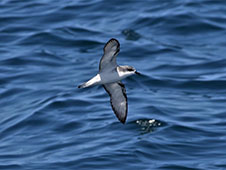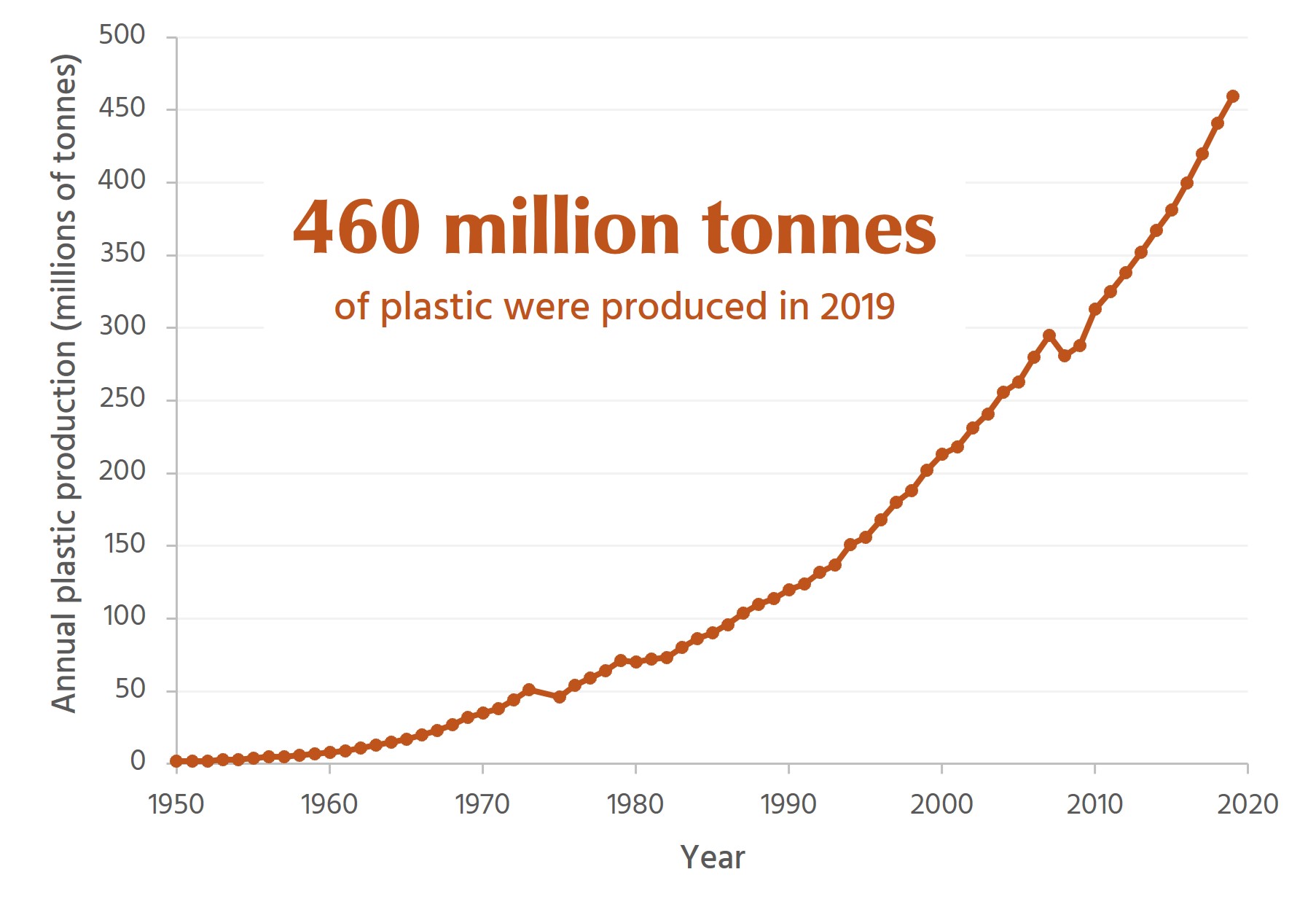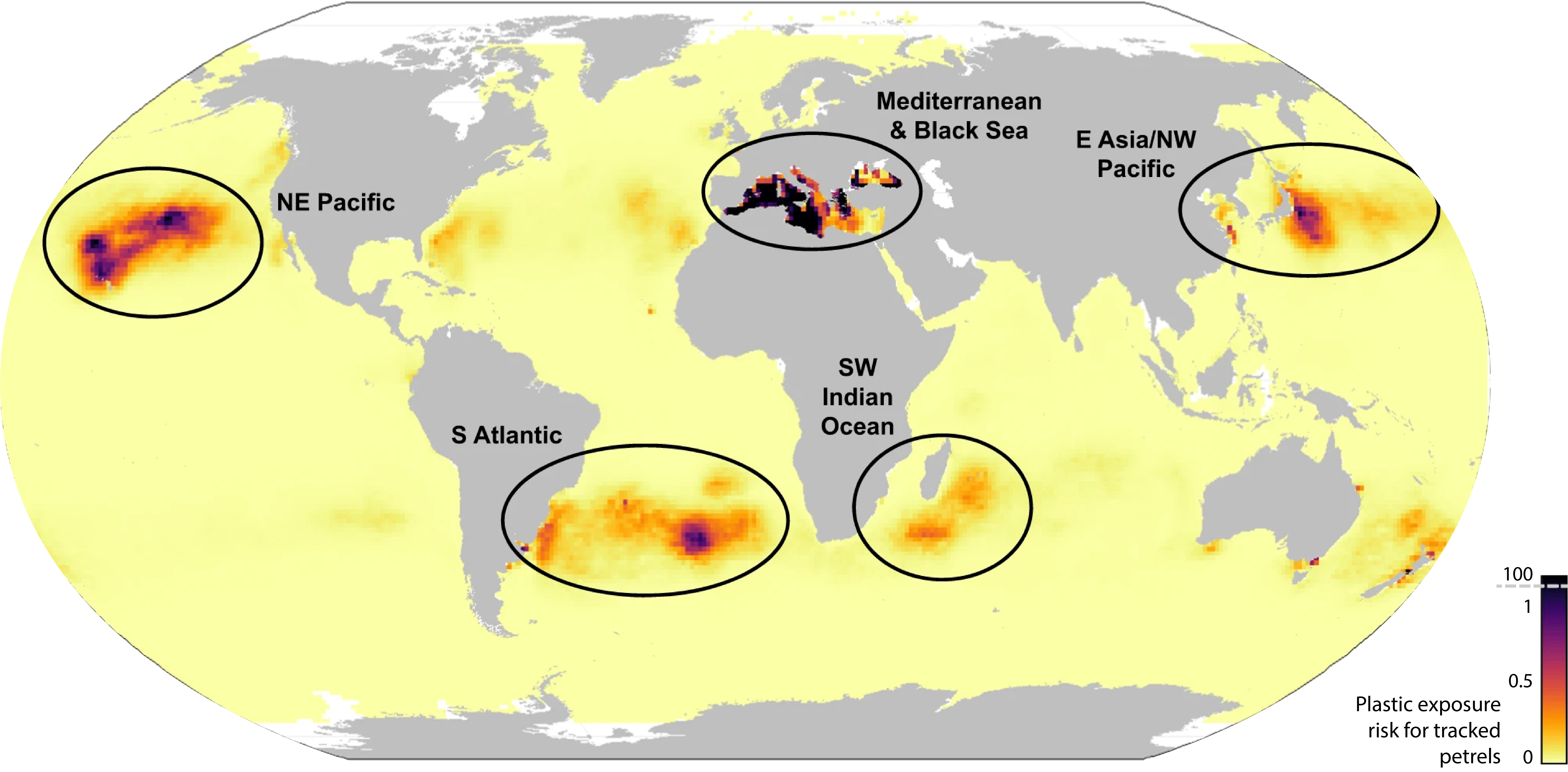
Rapidly increasing global plastic production alongside ineffective waste management has resulted in millions of tonnes of plastics in our oceans. These plastics are a threat to marine life, including seabirds, through entanglement and ingestion. Seabird tracking data combined with estimates of marine plastic density can reveal areas in which seabirds are at high risk of exposure to plastic pollution, and populations that regularly utilise these high-risk areas. Data from 77 tracked petrel species reveal hotspots of exposure risk in the Mediterranean and Black seas, and the northeast Pacific, northwest Pacific, South Atlantic and southwest Indian oceans. Worryingly, exposure risk is disproportionately high for globally threatened species.
The amount of plastic produced globally each year has increased exponentially, from 2 million tonnes in 1950 to 460 million tonnes in 2019 (see fig. 1; Ritchie et al. 2023). This has inevitably led to a corresponding increase in ocean plastic pollution due to poor waste management (Ostle et al. 2019). Seabirds, being ubiquitous and often high up the food chain, are excellent indicators of the health of our oceans and can be used to monitor environmental pollution (Burger & Gochfeld 2004).
Figure 1: Annual global plastic production between 1950 and 2019

Data from https://ourworldindata.org/plastic-pollution [Accessed 30/01/2024]
Plastic pollution poses a threat to marine life in two main ways: through entanglement, which may result in death due to drowning, starvation, or infected injuries; and through ingestion, which may have lethal or sublethal impacts as a result of chemical contamination, internal damage or intestinal blockages. Documented records of entanglement by plastics or other synthetic materials exist for at least 265 bird species (Ryan 2018), while records of ingestion exist for nearly 300 bird species (Santos et al. 2021). In both cases, the majority of species affected are marine birds.
Marine plastics are unevenly distributed throughout the world’s oceans, with larger densities often found along coastlines with dense human populations and in mid-ocean gyres. Similarly, seabirds are patchily distributed, with many species travelling vast distances across multiple oceans and political boundaries. In order to evaluate and effectively mitigate the impacts of plastic pollution on seabirds, we need to understand where these two distributions overlap, and identify species and populations at high risk.
Clark et al. (2023) used tracking data from >7,100 birds, combined with marine plastic density estimates, to estimate the risk of exposure to marine plastics for 77 species of petrel. Petrels are particularly vulnerable to the effects of plastic pollution because they exhibit high levels of ingestion (both directly and from their prey); their gut morphology often results in retention of ingested plastic for long periods; and their relatively small body size makes them more likely to suffer greater physical damage and higher metabolic costs. The study found that the highest risk of exposure occurred in the Mediterranean and Black seas, and in the northeast Pacific, northwest Pacific, South Atlantic and southwest Indian oceans (see fig. 2).
Figure 2: Hotspots of plastic exposure risk for tracked petrels

Exposure risk calculated by multiplying the density value in each cell for plastics by the value for petrels (both scaled to sum to 1). Values are capped at 1% for visualization due to extreme values, and all other values are shown on a linear scale. Black ellipses indicate areas of highest exposure risk identified for the 20 species with the highest exposure risk scores. From Clark et al. (2023)
Worryingly, globally threatened petrel species had a disproportionately higher risk of exposure than Least Concern or Near Threatened species. Among the species found to be mostly using areas with above-average plastic density were Critically Endangered Balearic Shearwater Puffinus mauretanicus and Newell’s Shearwater Puffinus newelli; Endangered Hawaiian Petrel Pterodroma sandwichensis; and Vulnerable Yelkouan Shearwater Puffinus yelkouan, Cook’s Petrel Pterodroma cookii and Spectacled Petrel Procellaria conspicillata.
Both plastics and seabirds cross multiple national boundaries, and 25% of global plastics exposure risk to tracked petrels occurs in the high seas (areas outside of national jurisdiction). Mitigating against plastic pollution in the Exclusive Economic Zone (EEZ) of the country in which a species breeds is therefore unlikely to be sufficient to protect the species throughout its annual cycle. Addressing the threat of plastic pollution will require improved international cooperation, collaboration, resource mobilisation and information exchange (Borrelle et al. 2017).
Related Species
References
Borrelle, S. B., Rochman, C. M., Liboiron, M., Bond, A. L., Lusher, A., Bradshaw, H. & Provencher, J. F. (2017) Why we need an international agreement on marine plastic pollution. PNAS 114 (38): 9994–9997
Burger, J. & Gochfeld, M. (2004) Marine Birds as Sentinels of Environmental Pollution. EcoHealth 1: 263–274
Clark, B. L., Carneiro, A. P. B., Pearmain, E. J. Rouyer, M., Clay, T. A., Cowger, W., Phillips, R. A., Manica, A., Hazin, C., Eriksen, M., González-Solís, J., Adams, J., Albores-Barajas, Y. V., Alfaro-Shigueto, J., Alho, M. S., Araujo, D. T., Arcos, J. M., Arnould, J. P. Y., Barbosa, N. J. P…Dias, M. P. (2023) Global assessment of marine plastic exposure risk for oceanic birds. Nat. Commun. 14: 3665
Ostle, C., Thompson, R. C., Broughton, D., Gregory, L., Wootton, M. & Johns, D. G. (2019) The rise in ocean plastics evidenced from a 60-year time series. Nat. Commun. 10: 1622
Ritchie, H., Samborska, V. & Roser, M. (2023) Plastic Pollution. Published online at OurWorldInData.org. Available at: https://ourworldindata.org/plastic-pollution [Accessed 29/01/2024]
Ryan, P. G. (2018) Entanglement of birds in plastics and other synthetic materials. Mar. Pollut. Bull. 135: 159–164
Santos, R. G., Machovsky-Capuska, G. E. & Andrades, R. (2021) Plastic ingestion as an evolutionary trap: Toward a holistic understanding. Science 373: 56–60
Compiled: 2024 Last updated: 2024
Recommended citation:
BirdLife International (2024)
Seabird tracking data reveal global hotspots of exposure to marine plastics .
Downloaded from https://datazone.birdlife.org/sowb/casestudy/seabird-tracking-data-reveal-global-hotspots-of-exposure-to-marine-plastics on 22/11/2024